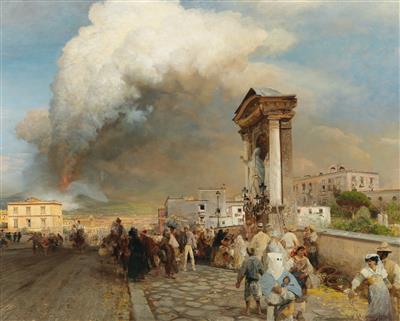Oswald Achenbach

(Düsseldorf 1827–1905)
The eruption of Vesuvius, signed, dated Osw. Achenbach 1890, oil on canvas, 122 x 152 cm, framed, (Rei)
Provenance:
Private Collection Düsseldorf;
Sale Düsseldorfer Auktionshaus, Steinbüchel, 19 April 1956;
Private Collection Germany;
Düsseldorfer Auktionshaus, 23 November 2012, lot 3;
Private Collection Germany.
…“a great deal of the Neapolitan population, expecting to watch their city suffer the same fate as Pompei, was rushing to the railway stations in order to flee. On the other hand, the superstition and religious bigotry were coming into play. Groups of women were running in the streets imploring and insulting Saint Januarius…”
This is how the 1872 eruption of Vesuvius was remembered by M. Guiraud, one of the many foreigners present in Naples at the time. Here, Oswald Achenbach gives us an almost identical illustration of the event: as the eruption is at its height in the background, destroying the towns of Massa di Somma and San Sebastiano, the population is fleeing on the via Ponte della Maddalena, while others are praying to Saint Januarius, the city’s patron.
The statue, still visible to this day, was created by the artist Francesco Celebrano and was erected after the eruption of 1767 when the saint had stopped the lava from reaching the city. He is represented with one arm oriented towards the volcano, preventing further destruction, forever protecting the people of Naples.
To the right of the statue, the seemingly unimportant graffiti “Verdi” does not refer to the artist, but is rather the acronym used during the Risorgimento for “Vittorio Emanuele Re D’Italia”, a detail that would have been missed by many at the time. The figures are also carefully selected; in the crowd we recognize a scugnizzo, women wearing the ciociara and a member of the Madonna dell’Arco brotherhood. Although the composition of the painting leads our view into the background, where the main event is happening, once we let our attention wander and allow ourselves to take in these rich details we notice the understanding of the Neapolitan culture Achenbach had gained from his numerous trips to Italy, and can truly appreciate the ability the painter had to transport us to the South of Italy through his works.
Esperta: Mag. Dimitra Reimüller
 Mag. Dimitra Reimüller
Mag. Dimitra Reimüller
+43-1-515 60-355
19c.paintings@dorotheum.at
25.04.2018 - 17:00
- Stima:
-
EUR 150.000,- a EUR 200.000,-
Oswald Achenbach
(Düsseldorf 1827–1905)
The eruption of Vesuvius, signed, dated Osw. Achenbach 1890, oil on canvas, 122 x 152 cm, framed, (Rei)
Provenance:
Private Collection Düsseldorf;
Sale Düsseldorfer Auktionshaus, Steinbüchel, 19 April 1956;
Private Collection Germany;
Düsseldorfer Auktionshaus, 23 November 2012, lot 3;
Private Collection Germany.
…“a great deal of the Neapolitan population, expecting to watch their city suffer the same fate as Pompei, was rushing to the railway stations in order to flee. On the other hand, the superstition and religious bigotry were coming into play. Groups of women were running in the streets imploring and insulting Saint Januarius…”
This is how the 1872 eruption of Vesuvius was remembered by M. Guiraud, one of the many foreigners present in Naples at the time. Here, Oswald Achenbach gives us an almost identical illustration of the event: as the eruption is at its height in the background, destroying the towns of Massa di Somma and San Sebastiano, the population is fleeing on the via Ponte della Maddalena, while others are praying to Saint Januarius, the city’s patron.
The statue, still visible to this day, was created by the artist Francesco Celebrano and was erected after the eruption of 1767 when the saint had stopped the lava from reaching the city. He is represented with one arm oriented towards the volcano, preventing further destruction, forever protecting the people of Naples.
To the right of the statue, the seemingly unimportant graffiti “Verdi” does not refer to the artist, but is rather the acronym used during the Risorgimento for “Vittorio Emanuele Re D’Italia”, a detail that would have been missed by many at the time. The figures are also carefully selected; in the crowd we recognize a scugnizzo, women wearing the ciociara and a member of the Madonna dell’Arco brotherhood. Although the composition of the painting leads our view into the background, where the main event is happening, once we let our attention wander and allow ourselves to take in these rich details we notice the understanding of the Neapolitan culture Achenbach had gained from his numerous trips to Italy, and can truly appreciate the ability the painter had to transport us to the South of Italy through his works.
Esperta: Mag. Dimitra Reimüller
 Mag. Dimitra Reimüller
Mag. Dimitra Reimüller
+43-1-515 60-355
19c.paintings@dorotheum.at
|
Hotline dell'acquirente
lun-ven: 10.00 - 17.00
kundendienst@dorotheum.at +43 1 515 60 200 |
| Asta: | Dipinti dell’Ottocento |
| Tipo d'asta: | Asta in sala |
| Data: | 25.04.2018 - 17:00 |
| Luogo dell'asta: | Wien | Palais Dorotheum |
| Esposizione: | 14.04. - 25.04.2018 |
